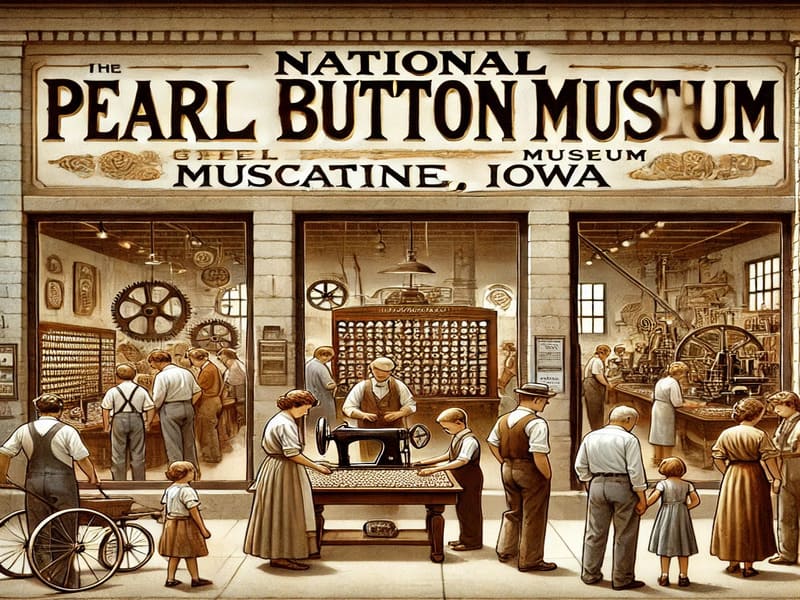Meet Muscatine – Stretching gracefully along the banks of the mighty Mississippi River, the Mississippi Riverfront Trail in Muscatine, Iowa, is more than just a walking path it’s a living connection between past and present, nature and city, activity and tranquility. Spanning several miles, this trail invites residents and visitors alike to explore one of the most scenic and culturally rich corridors in the American Midwest.
A Trail Carved by Nature and Legacy
Muscatine’s stretch of the Mississippi has long been a symbol of commerce, transportation, and identity. Known as the “Pearl Button Capital of the World” in the late 1800s and early 1900s, the city’s riverfront was once bustling with factories, paddleboats, and railways. Today, the Mississippi Riverfront Trail offers a rejuvenated version of this historic site, carefully designed to blend Muscatine’s rich industrial past with its vibrant present.
The trail winds past restored buildings, vintage lampposts, murals, and sculptures that pay tribute to the city’s working-class roots and its relationship with the river. Along the way, visitors are treated to breathtaking views of the Mississippi, especially during sunrise and sunset, when the water reflects hues of gold and deep blue.
Also Read : Mini Cheese Croissants: Savory Delight by Le Stanze Bistrot Cafe
Features That Invite Exploration
From a practical standpoint, the Mississippi Riverfront Trail is designed for everyone. Whether you’re an avid cyclist, a casual jogger, a parent pushing a stroller, or someone simply looking for a peaceful place to reflect, the trail accommodates it all. Its wide, well-maintained concrete and asphalt pathways allow for comfortable use year-round.
Key highlights along the trail include:
- Riverside Park, a central hub with picnic shelters, a skate park, splash pad, and seasonal events.
- The Riverview Center, where visitors can learn more about Muscatine’s cultural and natural heritage.
- Scenic overlook platforms and benches that allow for quiet moments with panoramic river views.
- Public art installations, including sculptures and interactive exhibits honoring the river’s ecological importance.
- Connectivity to broader trails, including connections to Kent Stein Park and Deep Lakes Park for those looking to extend their outdoor experience.
Riverfront Events and Community Spirit
The Mississippi Riverfront Trail is more than a path it’s a gathering space. Throughout the year, the trail and adjacent parks host various festivals, concerts, markets, and athletic events. One of the most popular events is the Muscatine 4th of July Celebration, which brings families from all over the region to watch fireworks reflected over the river.
In warmer months, local vendors set up booths along the trail, offering everything from lemonade to hand-crafted goods. Live music performances and community fitness classes, including yoga by the river, have become common on weekends.
The trail also serves as a canvas for community art, where school groups and local artists contribute murals and seasonal decorations. These contributions add warmth and personality to the trail, reinforcing Muscatine’s strong sense of identity and pride.
Also Read : Sunset Grove Park: Where Golden Hours and Family Picnics Meet
Ecological Education and River Awareness
One of the most overlooked but impactful aspects of the Mississippi Riverfront Trail is its role in environmental education. Several informational signs placed along the trail teach visitors about:
- Native plant species and the importance of preserving riparian zones.
- The history and ecology of the Upper Mississippi River National Wildlife and Fish Refuge.
- Floodplain awareness, including how Muscatine has implemented sustainable flood control measures.
- The role of the river in supporting bird migration and wetland diversity.
For educators, parents, or curious travelers, these stops turn a casual walk into a learning experience. They also encourage deeper respect for the fragile balance between urban development and natural preservation.
Trailside Dining, Relaxation, and Sunset Spots
Unlike more remote trails, the Mississippi Riverfront Trail seamlessly integrates nature with urban amenities. Along the path, especially near downtown Muscatine, visitors will find charming cafes, ice cream stands, and restaurants with river-view patios. This makes it easy to combine a leisurely stroll with a memorable meal or relaxing coffee break.
One of the most beloved features is the sunset viewing area near the Norbert F. Beckey Bridge, where locals often gather to watch the sun dip behind the Mississippi, painting the water with streaks of orange, pink, and lavender. For many, it’s a moment of stillness that offers a sense of connection to the natural world and to the flow of time itself.
The Trail’s Future: Expansion and Accessibility
As Muscatine continues to invest in outdoor infrastructure, the Mississippi Riverfront Trail is set to grow. Future plans include extending the trail further south to link up with Deep Lakes Park and adding more interpretive signage, shade structures, and wayfinding systems. Accessibility improvements, such as braille maps and tactile guideways for the visually impaired, are also being considered.
In many ways, this trail reflects Muscatine’s vision of the future one where environmental sustainability, community wellness, and historical preservation go hand in hand.




